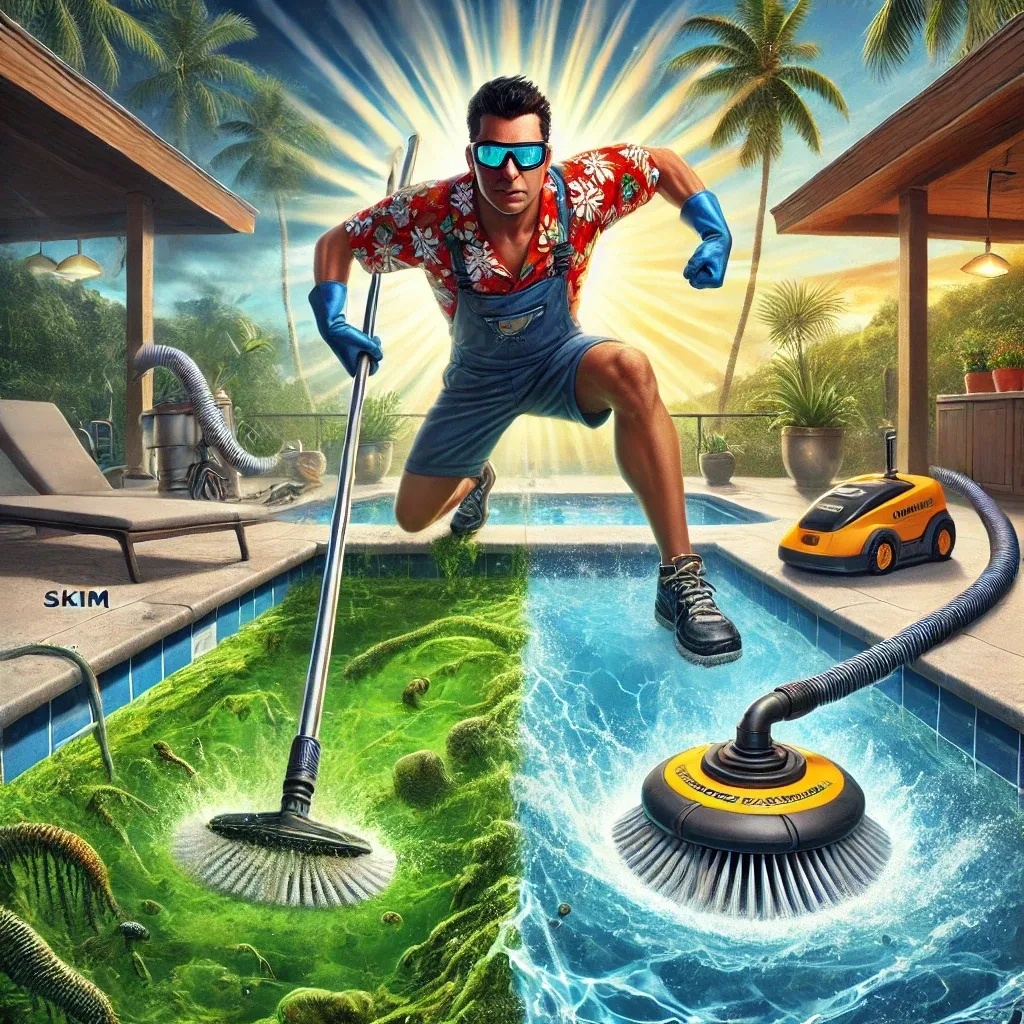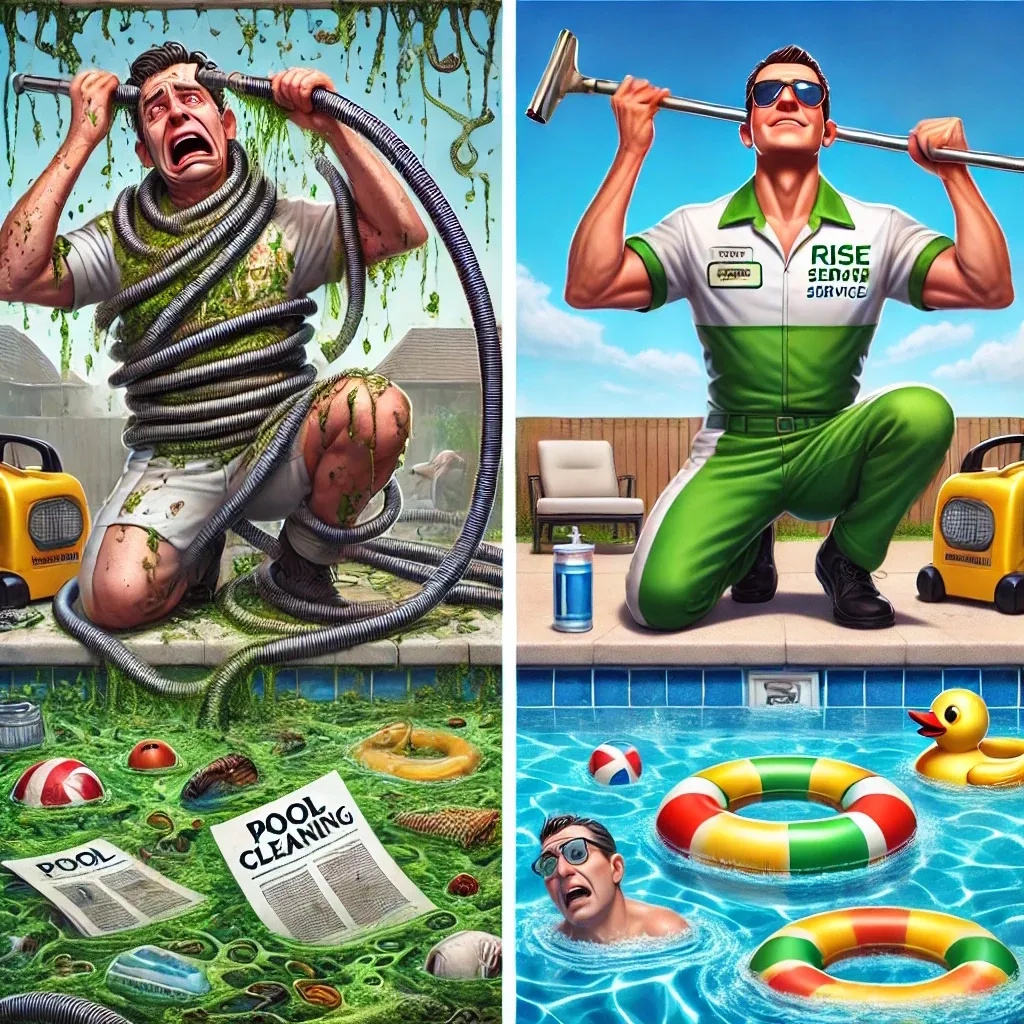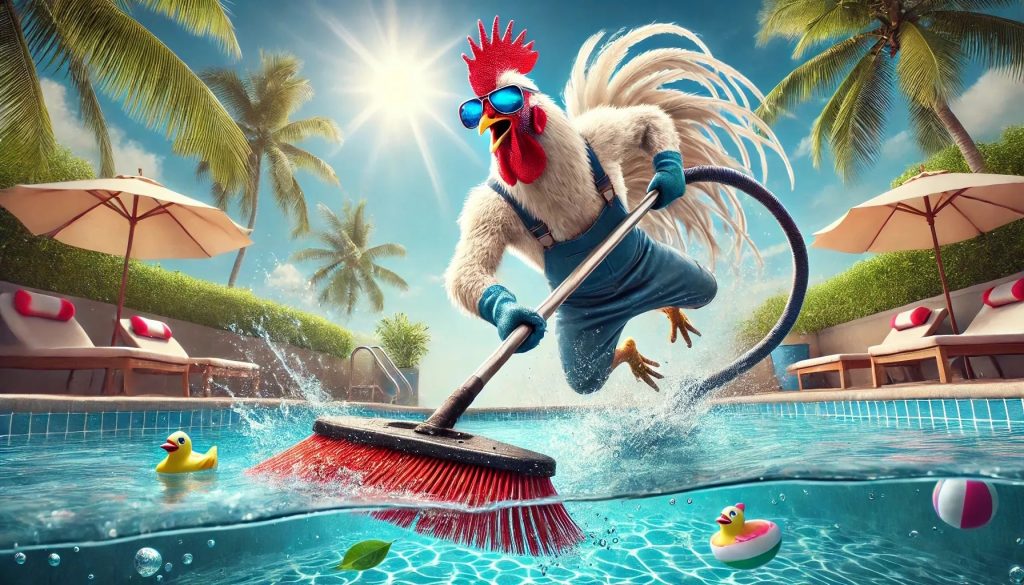If you own a pool, congratulations. You are now the proud parent of a giant, water-filled responsibility that behaves a lot like a pet. It requires regular care, attention, and the occasional intervention to prevent things from getting slimy. Treat your pool well, and it will reward you with countless hours of fun. Ignore it, and you may find yourself wading through a murky mess wondering if you accidentally built a frog sanctuary instead.
This guide is your essential walkthrough to keeping your pool clean, safe, and swim-ready with a consistent weekly pool maintenance checklist. Along the way, you will learn about the costs of neglect, the science behind algae and bacteria growth, and why your skimmer might just be your pool’s unsung hero.
Whether you are a new pool owner or a seasoned backyard swimmer, this article will elevate your understanding of effective pool maintenance and water care.
Why Regular Cleaning is Critical for Pool Health

Maintaining your pool regularly is not just about aesthetics, though the sight of crystal-clear water on a sunny afternoon is undeniably satisfying. The real reason consistent upkeep matters is because untreated water becomes a breeding ground for contaminants. Algae, bacteria, and debris can accumulate quickly, leading to unsafe conditions.
Circulation problems and poor chemical balance can cause irritation for swimmers and premature wear on expensive equipment. Once a pool begins to slip out of balance, it can spiral quickly into a full-blown maintenance nightmare. Regular cleaning ensures not only swimmer safety but also preserves the structural integrity and longevity of your backyard oasis. By dedicating time to pool maintenance, you also increase your comfort and peace of mind.
When you skip essential care, problems escalate rapidly. The water can turn cloudy and develop unpleasant odors. Swimmers may experience eye irritation, itchy skin, or even infections. Algae can bloom in various colors and textures, clinging stubbornly to walls, steps, and ladders. Bacteria thrive in stagnant, untreated water, creating an invisible health hazard. Most critically, neglected filtration systems become clogged and strained, increasing the risk of expensive breakdowns. Addressing issues proactively is always easier and more economical than managing an emergency. A thorough pool maintenance routine also lets you spot developing problems early, keeping your pool safe and functional.
The Five Core Steps of Pool Cleaning
To maintain a beautiful and healthy swimming environment, there are five key actions every pool owner must understand and perform regularly. These foundational steps are skimming, brushing, vacuuming, maintaining an efficient filtration system, and keeping your water chemistry in balance. These tasks form the backbone of your weekly pool maintenance checklist, and each one plays a crucial role in the overall cleanliness and health of your pool. With diligence and structure, these practices become second nature and significantly reduce the chance of future issues. When performed together, they create a holistic pool maintenance strategy that promotes both water clarity and safety.

Skimming the Surface
Skimming the surface of your pool should be one of the first tasks you tackle each week. This step involves removing visible debris such as leaves, insects, and other floating materials before they have the chance to sink to the bottom. If left unattended, this debris can decay, disrupting water quality and burdening your filtration system.
Regular skimming is a quick and highly effective way to maintain the visual appeal of your pool and improve its hygiene. It’s best done daily, especially during high-use seasons or when your pool is located near trees or plants. Skimmer baskets should be emptied weekly to prevent water flow issues and reduce strain on your pump. Proper skimming is a foundational element of effective pool maintenance.
Besides improving water clarity, frequent skimming also prevents the accumulation of organic material that could feed algae. Skimming doesn’t take long, but it can significantly reduce your cleaning workload over time. Treating this as a daily habit will make the rest of your cleaning tasks easier. Think of it as the quick tidy-up before the deeper clean—a small effort with a big payoff. Effective skimming supports your pool’s entire ecosystem by keeping it free of unwanted clutter and maintaining ideal flow conditions. Over time, this simple act becomes one of the most reliable habits in any pool maintenance plan.
Brushing Pool Walls and Surfaces
While skimming addresses the surface, brushing focuses on submerged areas that are prone to buildup. Brushing the walls, floor, steps, ladders, and corners of your pool at least once a week is essential to prevent algae growth and staining. Even if your pool appears clean, microscopic contaminants can settle in textured or hard-to-reach places. Algae especially thrive in shaded or low-circulation areas, and regular brushing helps disrupt their ability to colonize. Brushing also improves the effectiveness of your sanitizers by removing barriers that protect algae or bacteria. Including this task in your routine reinforces the importance of disciplined pool maintenance.
The type of brush you use matters. Soft-bristled brushes are ideal for vinyl liners, while harder surfaces like plaster or concrete benefit from stainless steel bristles. Brush slowly and methodically to avoid stirring up debris unnecessarily. Pay extra attention to spots with limited water circulation, such as behind ladders or along steps. When brushing becomes a routine, it reduces long-term maintenance challenges and enhances the overall cleanliness of your pool. It’s a vital step that often gets overlooked but has lasting benefits for water clarity and surface preservation. Inconsistent brushing is one of the most common gaps in otherwise solid pool maintenance routines.
Vacuuming the Pool Floor
No matter how well you skim and brush, fine debris will eventually settle on the bottom of your pool. That’s where vacuuming comes into play. This step removes dirt, sand, and organic matter that accumulate over time, which can cloud your water and provide nutrients for algae. Vacuuming should be done weekly and more often during periods of heavy usage or after storms. Both manual and automatic vacuums can get the job done, but the key is consistency and thoroughness. Regular vacuuming is a signature move in any successful pool maintenance strategy.
To vacuum effectively, move slowly and overlap your strokes, similar to vacuuming a carpet. Rushing can stir up sediment instead of removing it. Take your time and make sure to cover all areas, especially corners and steps where debris tends to settle. Vacuuming not only improves appearance but also supports water hygiene by eliminating the particles that filtration systems may miss. A clean floor contributes to balanced chemistry and overall swimmer comfort. Consistent vacuuming ensures that every inch of your pool remains clean and inviting. This attention to detail is what separates ordinary pool upkeep from truly excellent pool maintenance.
Maintaining the Filtration System
The filtration system is arguably the most critical component of a healthy pool. It constantly circulates water, removing impurities and helping distribute sanitizing chemicals. Without proper filtration, your other maintenance efforts will be significantly less effective. Pool filters should operate for at least eight hours a day during peak seasons to maintain ideal circulation. Depending on your system—whether it’s a sand, cartridge, or diatomaceous earth filter—you’ll need to perform specific maintenance like backwashing or replacing elements regularly. These tasks are central to keeping your pool maintenance efforts successful and sustainable.
Keep an eye on your system’s pressure gauge. A sudden increase in pressure often indicates that your filter needs cleaning. Ignoring this can result in clogged lines, reduced circulation, and eventual damage to your pump. Clean filters also reduce the need for chemical adjustments, as well-circulated water maintains its balance more easily. Routine inspections help catch leaks, cracks, or other problems early. Whether you’re managing a residential pool or a larger setup, consistent filter maintenance is non-negotiable for safe swimming and efficient system performance. As with any mechanical system, diligent pool maintenance directly impacts lifespan and efficiency.
Balancing Water Chemistry
Water chemistry might sound like the domain of scientists, but it’s an essential part of owning a pool. Each week, test your water using a reliable kit to check levels of pH, chlorine, alkalinity, and hardness. Balanced water prevents corrosion, staining, and bacterial growth, while also ensuring that sanitizers work properly. For most pools, the target pH range is between seven point two and seven point six, and chlorine levels should be kept between one and three parts per million. This type of pool maintenance requires precision, but it pays off with healthier, more inviting water.
If levels drift out of range, you’ll need to add the appropriate chemicals to restore balance. Additionally, pools should be shocked every one to two weeks, especially after periods of heavy use or rainfall, to eliminate contaminants and refresh sanitizer levels. Chemical balancing is a routine that, once mastered, becomes second nature. It’s not just about keeping water clear—it’s about safeguarding swimmer health and maintaining your equipment. Over time, a consistent approach to chemical care simplifies your overall maintenance routine and prevents costly issues from developing. The better your understanding of chemical relationships, the stronger your overall pool maintenance regimen becomes.
DIY vs. Professional Pool Maintenance

Some pool owners take pride in managing their own weekly tasks, finding the process rewarding and manageable. Performing the basics yourself—like skimming, brushing, and chemical testing—gives you full control over your pool’s condition.
However, it’s important to understand your limits. If your schedule becomes too busy or if issues like persistent algae or complex filter problems arise, it might be time to hire a professional service. Pool maintenance companies can perform in-depth cleanings, system diagnostics, and chemical rebalancing quickly and accurately.
If you’re wondering exactly when it’s time to call in the pros, check out our guide: Signs It’s Time to Hire a Professional Pool Cleaner. This covers all the warning signs, from stubborn algae to recurring equipment problems, and helps you decide if it’s time to bring in expert help.
Hiring professionals can be particularly helpful during seasonal transitions, when reopening or closing a pool properly can make or break your success for the season. Even if you handle day-to-day tasks, scheduling a professional check-up once per quarter can keep your system running efficiently and provide peace of mind. Combining your efforts with expert care allows you to enjoy the benefits of pool ownership without becoming overwhelmed.
Pool Care Horror Stories to Learn From
Neglecting your pool can have consequences far worse than a little cloudiness. One homeowner left town for several weeks, assuming their automatic chlorinator would handle everything. They returned to find dark green water, algae-covered surfaces, and a clogged filter system on the verge of failure. It took professional intervention, hundreds of dollars in chemicals, and days of cleaning to restore their pool.
Another case involved a new pool owner who didn’t know the importance of brushing and skipped it for two months. Even though they vacuumed and skimmed daily, the water developed an unpleasant odor and their walls became discolored. Eventually, permanent staining required resurfacing, costing thousands. These examples highlight how one overlooked aspect of pool maintenance can lead to disaster.
Common Pool Maintenance Mistakes
Many mistakes made by pool owners are easily avoidable. One of the most frequent is assuming clear water equals clean water. In reality, water can look fine while harboring chemical imbalances or bacteria. Another mistake is over-relying on automatic systems. While helpful, they are not replacements for manual inspections and adjustments. Pool maintenance requires consistent human oversight.
Skipping filter cleaning is another misstep. Clogged filters restrict circulation and reduce the effectiveness of your sanitizers. Forgetting to test water after storms or heavy usage can also create chemical chaos. To stay ahead of problems, treat your maintenance schedule as a priority, not a chore. Developing a solid understanding of these pitfalls makes your routine more reliable.
Pool Owner Q&A
How often should I clean my pool? Skim the surface daily, brush and vacuum weekly, and test the water chemistry once a week. These basic guidelines form the foundation of effective care. Is it okay to swim after adding chemicals? Generally, you should wait at least thirty minutes, but always check the product label. What is pool shock, and when should I use it? Shocking is the process of adding a high dose of chlorine to kill contaminants. Do it every one to two weeks or after heavy pool use. Should I get a robotic vacuum? Robotic vacuums can save time but should be part of a broader strategy. Nothing replaces a good maintenance checklist.
Final Checklist for Pool Maintenance

Your weekly pool maintenance checklist should include skimming debris, brushing surfaces, vacuuming the floor, testing chemical levels, and cleaning the skimmer basket. Monthly tasks should involve shocking the water, checking for leaks, and inspecting all equipment. Seasonally, prepare your pool for weather changes by adjusting chemical routines and checking that all systems are ready to handle temperature shifts.
Above all, consistency is key. A well-maintained pool is more enjoyable, more hygienic, and far less expensive to operate in the long run. Stick to the schedule, avoid common mistakes, and don’t be afraid to call in help when needed. When you invest in solid pool maintenance habits, you ensure your swimming space stays clean, safe, and fun for everyone.
